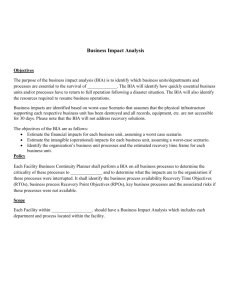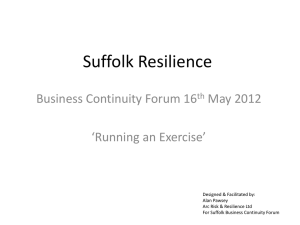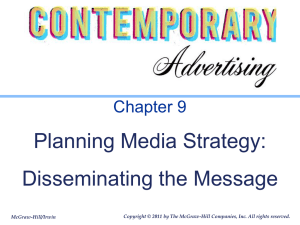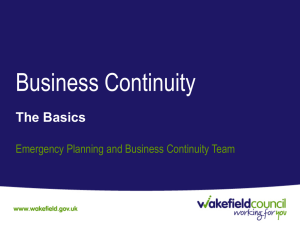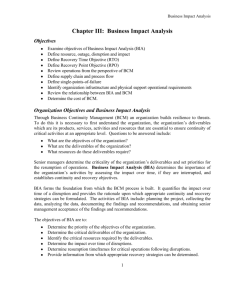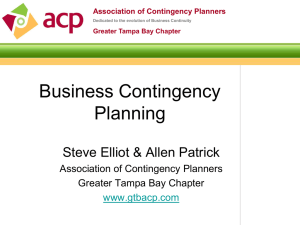Guidance - University of Exeter
advertisement
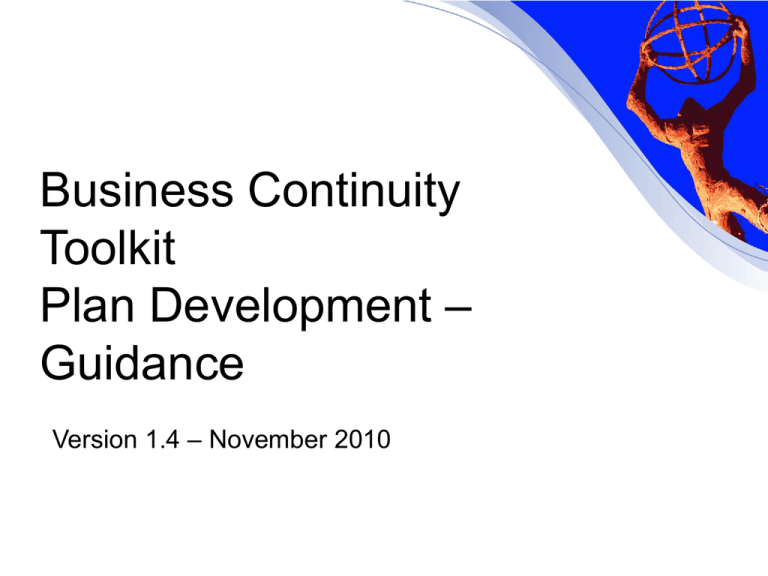
Business Continuity Toolkit Plan Development – Guidance Version 1.4 – November 2010 Acknowledgement • The University of Exeter’s Business Continuity Toolkit has been developed in collaboration with Back2business Ltd. • We are grateful to Mark Nicholas, (Commercial Director, Stem Group) for sharing his expertise and providing the framework for these toolkit resources. Contents 1 Introduction & Context 2 Business Continuity Planning 3 Plan Template 4 Recovery Priorities & Requirements 5 BC Strategies 1 Introduction & Context • This slide deck is intended to accompany the Business Continuity Plan for additional guidance purposes, in order to assist with the development of departmental plans. • It also references the ‘Risk, BIA & Strategy’ spreadsheet which once completed, should provide sufficient levels of detail to populate the relevant plan areas. 1 The Business Continuity Process • Risk & BIA Framework – Agree timeframes, metrics (RTO, RPO), define critical functions • Discuss & explore potential strategies and solutions – IT – Office & Admin Functions • Framework for Incident Response and Continuity Plans • Other – Review provided data – e.g. IT DR Statement 1 Introduction & Context (3) • Where we are now • What we need you to do – Complete Risk, BIA & Strategy information to cover gaps in the plans – Provide Recovery Timeframes (RTO) – Provide recovery profile for people over time – Identify Applications & Systems 2 BC Planning is defined as… • Business Continuity Planning is the process of advanced planning and preparation to protect against potential loss by formulating and implementing viable strategies and to document them in the form of a plan. • A BC plan is a documented collection of resources, procedures, tasks, strategy and information that is developed, compiled and maintained in readiness for use following an incident, or crisis situation. • Remember, this is a living document! 2 Where does my Business Continuity Plan fit in? Structure, Roles and Responsibilities (An example) S T R A T E G I C T A C T I C A INCIDENT RESPONSE TEAM LEADER DIR COMMS DIR AS DIR PERS DIR CaS DEPTY DIR COMMS LEGAL ASST DIR IT H o PROPY SERVS LIBRARY STUDENT SERVS INTERN’L OFFICE TECH & INFRASTR SECURITY CONFS & RETAIL H&S FACILITIES NETWORKS HELP DESK TRANSP’RT REGISTRY ACAD’MICS ACCOMMODATION ELEC ENGR LAB TECH’NS SNR DPTY VC ED Gold Incident Response Plan Silver Business Continuity Plans L O P E R A T N L Bronze Operational/ Business As Usual Processes See slide notes for more information 3 Business Continuity Plan – Roles • BC Team Leader/Plan Owner • Deputies, possibly 1 or 2 depending on number of functions/activities • BC Team Members • There is no need to include all recovered staff in the team plan, just those involved in the recovery activities 3 Business Continuity Plan – Template Guidance • Text within template which is currently in Italics will need to be – Replaced with your own information – Or deleted, as it is for guidance purposes only • Plans need to exist for the most appropriate business critical activities – Guideline should be from ‘Immediate’ to 5/8 days. Anything beyond this will be a judgement call on whether strategies or recovery procedures are required by you – Simplify or combine Activities or Processes where appropriate (there is no need to list every process/activity as per the BIA feedback – be sensible, as this plan needs to be meaningful and usable!) – Collaborate and collude with other depts & functions where necessary, e.g. where a process crosses several functions 4 Business Continuity Plan Recovery Priorities & Requirements • Section 3 of the Plan Template. List Business Critical Activities for function/dept – here you should reference the ‘Risk, BIA & Strategy’ spreadsheet where you should find completed; – RTO’s & RPO for Colleges / Departments critical functions & activities – Application and Systems for each critical activity • • (Delete Italic directions in plan once finished) Note: any resources, procedures or strategies which are put forward by plan owners will be considered by Insurance & Business Continuity Services to ensure that there are no grey areas or overlaps. 5 Business Continuity Plan – Strategy Development • From ‘Do Nothing’ to ‘Do Everything’ • Which Strategies are cost effective? – Will require time to implement, cost more or a lot, easy wins – Consider the sliding scale from localised problems to Worst Case Scenario (e.g. Denial of Access to Campus/College/Building) • Consider staff, IT (applications & data), lecture resources, facilities, specialised equipment • For more strategy options – please refer to next slide Business Continuity Plan – Recovery Strategies 5 • • • • What Strategies could you employ for people? – Working from home? – Working from 3rd party? (supplier, partner, specialist provider) What Strategies could you employ for IT? – Broadband, Dongle, telephony, VPN, Laptop – Backup/replicated systems, remote access, cold start up What Strategies could you employ for Processes/Activities? – Manual workarounds, paper based systems – Outsource, reciprocal agreements Consider running a strategy workshop to develop viable options Populate Section 4 of the Plan with these options and those derived in the Risk, BIA & Strategy options spreadsheet. See Crisis Definition table overleaf > 5 Business Continuity Plan – Recovery Strategies • As defined for Incident Declaration purposes. • Consider if your plan would address the relevant scenarios for Levels 2 & 3 • Challenge any assumptions Next Steps • • • • • Start the BIA Come to the clinics in December and January for support Complete your plans Carry out an exercise (this can be fun!) Review content – Strategies, requirements and resources – Feasibility – ‘Fitness for Purpose’ For further guidance and support, please email or call: Sue Dummett buscont@ex.ac.uk 01392 72 5768



